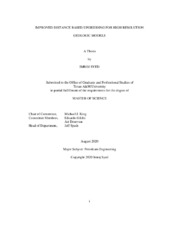| dc.contributor.advisor | King, Michael J. | |
| dc.creator | Syed, Imroj | |
| dc.date.accessioned | 2021-02-22T20:15:29Z | |
| dc.date.available | 2021-02-22T20:15:29Z | |
| dc.date.created | 2020-08 | |
| dc.date.issued | 2020-07-30 | |
| dc.date.submitted | August 2020 | |
| dc.identifier.uri | https://hdl.handle.net/1969.1/192615 | |
| dc.description.abstract | Strong heterogeneities in properties characterize subsurface reservoirs and the encapsulation of these properties play an important role in optimizing the trade-off between preservation of geologic heterogeneity and reservoir simulation cost efficiency. The motivation of upgridding and upscaling high resolution geologic models is to develop practical and relatively low-resolution grids that are cost effective to run flow simulations whilst preserving as much reservoir heterogeneity as possible.
Upgridding high-resolution geologic models to considerably lower-resolution simulation models has always been extremely challenging for reservoir modeling and flow simulation, owing to the high heterogeneity and the complex controls on the porosity and permeability. In the past decades, development of high-resolution geologic models incorporated inclusion of greater detail in order to capture the spatial distribution of heterogeneity in rock properties, which affected oil and gas recovery. Orders of magnitude of cells are often encountered for geologic grids. Such high orders of magnitude are too expensive for routine flow simulation computations. Consequently, we develop and apply different upgridding algorithms applied across multiple reservoirs with varied distribution of heterogeneity and aim to maintain the best trade-off between preservation of information and minimization of cost.
In order to develop an optimized upgridding approach, various factors of the models have been taken into consideration. Combination of those factors lead to different choices in how we assess the reservoir heterogeneity that form the building blocks of different upgridding approaches. We develop and apply a variety of upgridding schemes (layer designs) for diverse geologic models and observe how the different algorithms behave.
The current study of multiple algorithms and their upgridding performance for various models has led to the development of a novel distance-based upgridding technique which appears to be more effective in terms of characterizing the physical model properties. This approach is developed and applied in the current study. | en |
| dc.format.mimetype | application/pdf | |
| dc.language.iso | en | |
| dc.subject | Upgridding, Distance-Based Upgridding, Zonal Upgridding, Amellago | en |
| dc.title | Improved Distance Based Upgridding for High Resolution Geologic Models | en |
| dc.type | Thesis | en |
| thesis.degree.department | Petroleum Engineering | en |
| thesis.degree.discipline | Petroleum Engineering | en |
| thesis.degree.grantor | Texas A&M University | en |
| thesis.degree.name | Master of Science | en |
| thesis.degree.level | Masters | en |
| dc.contributor.committeeMember | Gildin, Eduardo | |
| dc.contributor.committeeMember | Donovan, Art | |
| dc.type.material | text | en |
| dc.date.updated | 2021-02-22T20:15:29Z | |
| local.etdauthor.orcid | 0000-0001-6166-3375 | |


